Millbank Surname Ancestry ResultsOur indexes 1000-1999 include entries for the spelling 'millbank'. In the period you have requested, we have the following 33 records (displaying 21 to 30): Single Surname Subscription | | | Buying all 33 results of this search individually would cost £184.00. But you can have free access to all 33 records for a year, to view, to save and print, for £100. Save £84.00. More... |
These sample scans are from the original record. You will get scans of the full pages or articles where the surname you searched for has been found. Your web browser may prevent the sample windows from opening; in this case please change your browser settings to allow pop-up windows from this site.  Outstanding soldiers of the Essex Regiment
(1881-1901) Outstanding soldiers of the Essex Regiment
(1881-1901)
Each year the best soldiers of the regiment were chosen for long service and good conduct medals. This register gives rank, name, regimental number, and date of recommendation. (The sample scan is from the East Surrey regiment). The register is essentially a register of recommendations, annotated with details of the issue of the medals. Where no gratuity accompanied the medal, the entry is marked 'W. G.' (without gratuity); where, for one reason or another, the medal was not issued, the entry is marked 'N. S.' (not sanctioned) and struck through. The regiment was based on the 44th Regimental District - Warley. The 1st battalion returned from India 28 November 1884, and in 1885 was stationed at Colchester, and in 1895 at Fermoy. The 2nd battalion embarked for Gibraltar in 1882, was in Egypt by 1884, adding "Nile, 1884-85" to the regimental honours. The battalion was moved to Malta in 1887; on to Cyprus in 1889; and thence to India in 1892, and was stationed at Lucknow by 1895. The battalion was then transferred to South Africa, where it gained the honours "South Africa, 1899-1902", "Relief of Kimberley" and "Paardeberg" for the regiment.MILLBANK. Cost: £8.00.  | Sample scan, click to enlarge
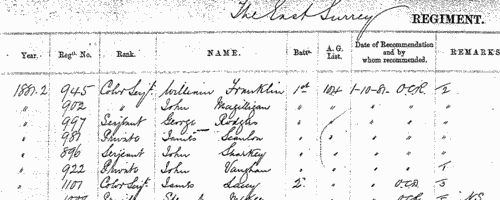
| Divorcees
(1930)
On Mondays during the law terms the Probate, Divorce, and Admiralty Division of the High Court of Justice issued lists of divorce decrees nisi that had been declared absolute, the final stage of the divorce proceedings. The lists posted by the court appeared in various Tuesday newspapers, including The Times. The surname and initials of the husband and wife are given, except in those cases where a co-respondent was cited as having committed adultery with the wife; then the initials are omitted, with the co-respondent's surname added as a second defendant. This is the index to the divorcees.MILLBANK. Cost: £6.00.  | Sample scan, click to enlarge
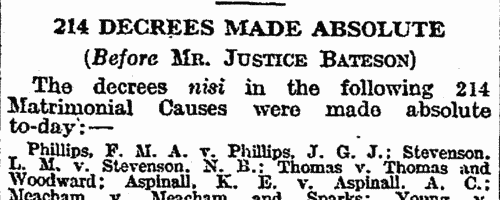
| Scientific Poultry Breeders
(1932)
The Scientific Poultry Breeders Association was by far the largest poultry society in Great Britain, with 16,109 members for the year 1930-1931. This seventeenth annual register, for the year 1932, lists members alphabetically by surname and initials, with addresses. P. F. stands for Poultry Farm.MILLBANK. Cost: £4.00.  | Sample scan, click to enlarge

| Congregationalists
(1935)
Who's Who in Congregationalism gives biographical notices of accredited ministers and evangelists, lay pastors and lay officials of the Congregational church in Britain and Ireland. The notices also include the names of wives, with maiden names, and these too are included in the index here.MILLBANK. Cost: £6.00.  | Sample scan, click to enlarge
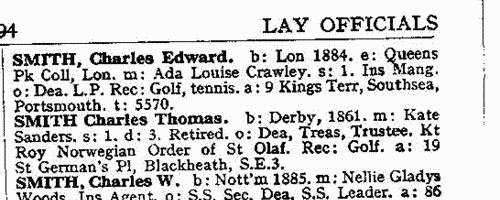
| London Telephone Subscribers
(1939)
The London telephone directory lists subscribers alphabetically by surname and then by christian name or initials, with their postal address and telephone number. This is the L to Z directory issued in May 1939, but also contains some names from earlier in the alphabet, for instance in the separate section for midwives. The London telephone districts comprised not only the city centre, but also the very extensive suburbs in the Home Counties (Essex, Kent, Surrey and Middlesex).MILLBANK. Cost: £4.00.  | Sample scan, click to enlarge

| Boys entering Gresham's School
(1940)
The Sir John Gresham Grammar School at Holt in Norfolk was founded by sir John, who bought the manor house there in 1546 to convert it into a school, and building work had started by 1555. To celebrate the quatercentenary in 1955, a history of the school written by the Reverend C. L. S. Linnell was published, together with an Alumni Greshamienses, a register of boys entering the school from 1562 to 1954, compiled by A. B. Douglas. The materials to hand for the register for the early years were slight; the first coherent lists of boys survive only from 1729, and then are fitful, with little detail, and largely missing from 1784 to 1803; however, from 1810 onwards the names of boys' parents are usually recorded. The register is arranged chronologically by year (and from 1900 by term - L, Lent; M, Michaelmas; S, Summer), and then alphabetically by surname (in capitals) and christian name(s). Where known, year of birth is then given (in brackets), names, addresses and occupations of parents. From 1900 onwards there are italic abbreviations for sporting achievements at school (h, hockey colours; VIII, shooting colours; S, first-class swimmer; XI, cricket colours; XV, football colours), and p for house prefect and P for school prefect; then (in italics) information about the boy's adult life, and his address (where living) at the time of publication. Finally, on the right hand side of the page, in italics, is given the year of his leaving the school. Most detail is absent before 1810; and, of course, for the boys still at school in 1955, or only recently left, there are no details of future career; nor are there the usual details about their parentage. From 1898 onwards day boys are noted with an italic D (N means Newquay dayboy); and from 1900 onwards the school houses are shown (B, Bengal Lodge; F, Farfield; H, School House or Howson's; K, Kenwyn; O, Old School House; W, Woodlands); and, for the junior school, c, Crossways; k, Kenwyn; o, Old School House).MILLBANK. Cost: £4.00.  | Sample scan, click to enlarge
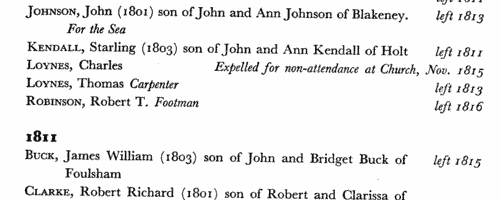
| British Civil Servants
(1940)
The British Imperial Calendar lists civil servants in Britain, arranged according to the organizational structure of the state, and shows their qualifications and salaries. MILLBANK. Cost: £4.00.  | Sample scan, click to enlarge
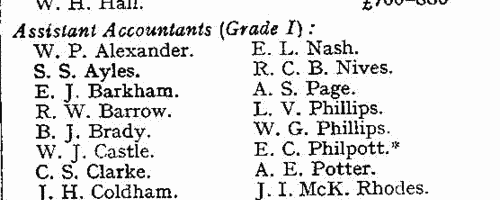
| Boys entering Gresham's School
(1943)
The Sir John Gresham Grammar School at Holt in Norfolk was founded by sir John, who bought the manor house there in 1546 to convert it into a school, and building work had started by 1555. To celebrate the quatercentenary in 1955, a history of the school written by the Reverend C. L. S. Linnell was published, together with an Alumni Greshamienses, a register of boys entering the school from 1562 to 1954, compiled by A. B. Douglas. The materials to hand for the register for the early years were slight; the first coherent lists of boys survive only from 1729, and then are fitful, with little detail, and largely missing from 1784 to 1803; however, from 1810 onwards the names of boys' parents are usually recorded. The register is arranged chronologically by year (and from 1900 by term - L, Lent; M, Michaelmas; S, Summer), and then alphabetically by surname (in capitals) and christian name(s). Where known, year of birth is then given (in brackets), names, addresses and occupations of parents. From 1900 onwards there are italic abbreviations for sporting achievements at school (h, hockey colours; VIII, shooting colours; S, first-class swimmer; XI, cricket colours; XV, football colours), and p for house prefect and P for school prefect; then (in italics) information about the boy's adult life, and his address (where living) at the time of publication. Finally, on the right hand side of the page, in italics, is given the year of his leaving the school. Most detail is absent before 1810; and, of course, for the boys still at school in 1955, or only recently left, there are no details of future career; nor are there the usual details about their parentage. From 1898 onwards day boys are noted with an italic D (N means Newquay dayboy); and from 1900 onwards the school houses are shown (B, Bengal Lodge; F, Farfield; H, School House or Howson's; K, Kenwyn; O, Old School House; W, Woodlands); and, for the junior school, c, Crossways; k, Kenwyn; o, Old School House).MILLBANK. Cost: £4.00.  | Sample scan, click to enlarge
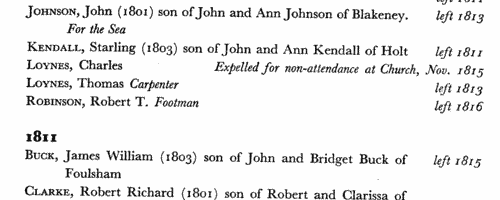
| Owners and Breeders of Friesian Cattle
(1951)
The British Friesian Cattle Society registered the pedigrees of pure Friesian cattle in the United Kingdom. This list of members is corrected to 10 April 1951, and gives full name (surname first), address, and where the member owned a herd, the prefix attributed to that herd. A dagger in front of an entry indicates that the herd was attested. MILLBANK. Cost: £4.00.  | Sample scan, click to enlarge

| British Civil Servants
(1953)
The British Imperial Calendar lists civil servants in Britain, arranged according to the organizational structure of the state, and shows their qualifications and salaries. MILLBANK. Cost: £4.00.  | Sample scan, click to enlarge
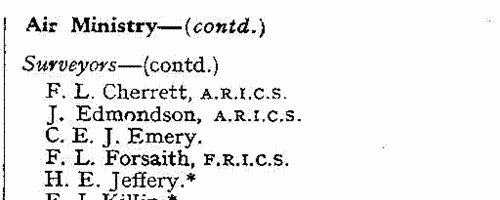
|
Research your ancestry, family history, genealogy and one-name study by direct access to original records and archives indexed by surname.
|













